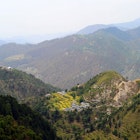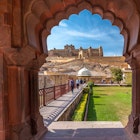
Dec 11, 2019 • 5 min read

Sep 19, 2014 • 6 min read

Whitewashed monastic buildings at Thiksey Gompa, Ladakh. Image by Saad Faruque / CC BY 2.0.
One of the most surprising things about the Himalaya is how this desolate, almost monochrome landscape has produced so much vivid colour. From Kathmandu to Dharamsala and Lhasa to Ladakh, Tibetan Buddhist monasteries, or gompas, guard a treasure trove of religious art, executed in an almost hallucinogenic palette of pigments and dyes.

Behind the whitewashed walls of every Tibetan Buddhist monastery lurks a hidden world of golden sculptures and rainbow-coloured murals. These radiant artworks were clearly not inspired by the grey and ochre colour scheme of the Himalayan landscape; Tibetan Buddhist art is, at its purest level, art of the imagination.
Travellers who delve into this mysterious world are confronted by an incredible panoply of deities, mythical beings and symbolism. Everything, from the layout of buildings to the precise positions of human figures in paintings and murals, is dictated by ancient principles of spirituality, geometry, and numerology. There are even rules for the direction that pilgrims must walk around Buddhist monuments – always clockwise, the same direction that Buddhist prayer wheels should be spun.
For first timers, it can all be a little overwhelming, so here is Lonely Planet's quick guide to gompas, to help you sort your lamas from your lha khangs.
Helpfully, gompas provide a handy crib-sheet for the key principles of Tibetan Buddhism in the form of the Bhavachakra, or Wheel of Life, depicted in the entrance of almost every Tibetan Buddhist monastery. In this informative graphic, a demonic-looking figure representing Impermanence holds an enormous wheel, whose rim depicts the principle of karma – the law of cause and effect – as beings are drawn up towards enlightenment or down towards the lower realms as a consequence of their actions.
Inside the wheel are the six realms, where gods, demi-gods, humans, animals, hungry ghosts and the damned endure lives of suffering because of the 'three poisons' depicted on the hub of the wheel – ignorance, attachment and aversion, represented respectively by a pig, snake and bird. That's a lot of symbolism in one painting!

The interiors of Tibetan Buddhist monasteries are filled with statues and vivid murals of Buddhist deities that can be read like a textbook of Tibetan spiritualism for those who understand the complex symbolism of every figure, shape and gesture. Not for nothing are the chapels of Buddhist monasteries known as lha khang – literally, the residence (khang) of god (lha).

As you might expect, Buddha is depicted frequently, but the question is, which Buddha? It could be Sakyamuni (Siddhartha Gautama), the historical Buddha, who was born in Lumbini in Nepal in around the 5th century BC and achieved enlightenment at Bodhgaya in India. It could be Maitreya, the future Buddha, who will one day be born on earth to lead humanity to enlightenment. It could be one of the five Dhyani Buddhas, representing five perfect qualities of the Buddha. It could be the medicine Buddha, the great healer of Tibetan herbal medicine.
Or it could be any one of a legion of lamas (teachers) and bodhisattvas (enlightened beings) who helped spread Buddhism across the Himalaya. Some, like Manjushri, guardian of wisdom, are mythical and symbolic, while others are real historical figures. Padmasambhava (Guru Rinpoche), immediately recognisable by his protruding eyes and trident with impaled human heads, was an Indian Buddhist monk who trekked across the Himalaya in the 7th century, bringing Buddhism to Tibet, while the multi-armed figure of Avalokitesvara (Chenrezig), symbol of Buddhist compassion, is represented on earth by the Dalai Lama.

Every Tibetan Buddhist monastery is guarded by fearsome protector deities - the Dharmapala: demonic entities ringed by fire, with wild eyes, sharp claws, long fangs, garlands of human skulls and multiple arms carrying weapons and potent symbolic objects. But these are the good guys, protecting the dharma (Buddhist teachings) from the forces of ignorance, attachment and aversion. In case there was any doubt, these enlightened beings are depicted, like Buddha and the bodhisattvas, with a third eye, representing higher consciousness.
The Dharmapala are favourite figures for the elaborate masks worn for ceremonial Buddhist chaam dances, including such fearsome characters as Mahakala (Nagpa Chenpo), the Tantric Buddhist version of the Hindu god Shiva, and his consort Shri Devi (Palden Lamo), protector of Lhasa and the Dalai and Panchen lamas. If there are no masked dances taking place when you visit a gompa, ask to be shown the mask room, where the monstrous masks are stored between performances. Look out for the mythical snow lion, guardian of the Himalaya, and the skeletal face of Chitipati, lord of the charnel grounds.

The first chorten – the Tibetan Buddhist version of the stupa – was built to enshrine relics of the Buddha, but thousands more were constructed over the centuries by pilgrims and devotees seeking Buddhist merit. In the high-altitude deserts of Tibet, Mustang and Ladakh, lines of chortens stretch for miles across the landscape, like marker stones for regions where Tibetan Buddhism is practiced.
While mirroring the shapes in the surrounding landscape, the form of the chorten is a physical representation of the five perfect proportions of the body of Buddha, and the five elements in Buddhist philosophy. The square base of the stupa represents earth and the underworld; the bulbous middle portion represents water; the spire represents fire; the stylised umbrella at the tip represents the wind; and the stylised jewel, sun and moon at the apex represents the void of space. Enshrined within the shape are thirteen levels, symbolising the path to enlightenment.

While there are gompas and chortens across the Himalaya, many of the most dramatic are outside of Tibet, where Tibetan Buddhism escaped the purges of the Chinese Cultural Revolution. Here are our top ten spots to commune with Tibetan Buddhism.
The awe-inspiring former palace of the Dalai Lama, with a thousand rooms full of murals and Tibetan state treasures.

One of the great centres of learning, where three different orders of Tibetan Buddhism came together for contemplation around the great Gyantse kumbum (chorten).
The home of the Dalai lama, spiritual leader of Tibetan Buddhism, plus the Tibetan government in exile and 90,000 Tibetan refugees.
The world's second largest gompa after the Potala, hidden away in India's remote northeast.

A sublimely scenic dzong (fortress monastery), framed by the confluence of two rivers and a curtain of lilac-flowered jacaranda trees.
Less a monastery, more a city, perched on a rugged hilltop in the Indus Valley, enshrining a multi-storey statue of Maitreya, the future Buddha.
A treasure house of paintings and sculptures, preserved since the 10th century in a cluster of eroded, mud-brick chambers.

Nepal's largest stupa rises as a shimmering white dome atop a geometric base that creates a three dimensional mandala when viewed from above.
The great stupa of Swayambhunath soars above the rooftops on a hill that allegedly materialised when the Bodhisattva Manjushri drained the lake filling the Kathmandu Valley.
A sprawl of chapels and monks' dormitories in the Himalayan foothills, sitting in waiting for the exiled 17th Karmapa, spiritual leader of the black hat sect.
Joe Bindloss is Lonely Planet's South Asia Destination Editor.


Dec 11, 2019 • 5 min read




May 24, 2018 • 5 min read



